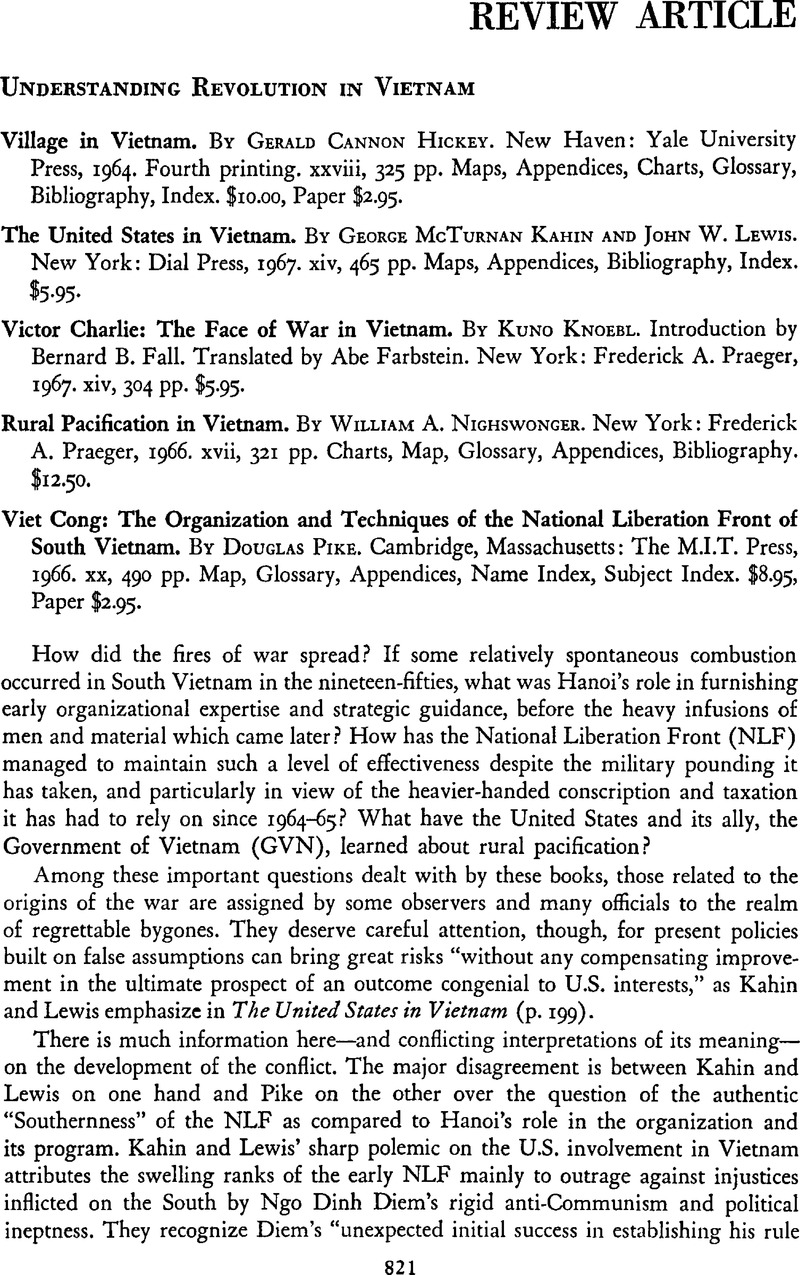No CrossRef data available.
Published online by Cambridge University Press: 23 March 2011

1 These various statements and actions by the North are described in the following sources, respectively: U. S. State Department White Paper of 1961, p. 15; Hoc Tap, January 1960; and Devillers, Philippe, “The Struggle for Unification,” China Quarterly, No. 9 (January–March 1962), p. 15Google Scholar. The last two items are referred to in Pike's book, p. 76.
2 This “Crimp Document,” distributed in an edited English version by the State Department's Bureau of Public Affairs, Washington, D. C, is described as having been captured by allied forces in Operation Crimp north of Saigon in early 1966. It is thought to be the notebook, written in about early 1963, of a ranking political cadre who kept therein his impressions of policy statements to which he had been exposed.
3 This NLF behavior and the activities of these village teams are described in my chapter, “South Vietnamese Voluntary Youth Associations: Social Commitment and Political Promise,” in a forthcoming volume on Vietnam to be edited by Ithiel de Sola Pool.
4 Vol. XXV, No. 1 (November 1965).
5 Ray, Michele, a French journalist, describes her visits to American combat units and her three weeks as an NLF captive in early 1967 in her impressionistic, more superficial book, The Two Shores of Hell. Translated by Abbot, Elisabeth. (New York: David McKay, 1968)Google Scholar. Like Knoebl, she was deeply impressed by the morale, dedication, and discipline of the NLF fighters and supporters she met in the area of her captivity and again, these had been regions under Vietminh and later NLF control for long periods.
6 Even the able analysis of “Terror as a Weapon” by Thomas Perry Thornton reflects disbelief regarding an important aspect of the subject when Thornton writes “Various sources suggest that [terror] has been used as a means of recruiting troops, but this suggestion seems incredible and has never been documented.” Internal War, Problems and Approaches, Eckstein, Harry, ed. (New York: The Free Press of Glencoe, 1964), p. 75Google Scholar.
7 Pike deals with this role of political agitation in his emphasis on political communication, or what he refers to as “a communicational view of social change” (p. ix, passim).
The growing new literature on this subject can be noted only briefly here. For surveys of the field see particularly Stone, Lawrence, “Theories of Revolution,” World Politics, XVIII, 2 (January 1966)Google Scholar; and Eckstein, Harry, “On the Etiology of Internal War,” History and Theory, IV, 2 (1965)Google Scholar. For some newer methodological approaches to this study, see the series of papers on political violence and revolution prepared for the September 1967 annual meeting of the American Political Science Association by Gurr, Ted, Wedge, Bryant, Free, Lloyd A. and others and Gurr's “Psychological Factors in Civil Violence,” World Politics, 20 (January 1968)CrossRefGoogle Scholar and “A Causal Model of Civil Strife: A Comparative Analysis Using New Indices,” American Political Science Review, LXII, 4 (December 1968)Google Scholar.
8 Many of Lucian Pye's observations about the role of hatred in Chinese politics are relevant here, as presented in The Spirit of Chinese Politics, A Psychocultural Study of the Authority Crisis in Political Development, Chap. 5, passim. (Cambridge, Mass.: MIT Press, 1968)Google Scholar.
9 Examples are the following publications of The RAND Corporation, Santa Monica, California, much of the research for which was based on interviews of NLF defectors and prisoners of war in Vietnam and upon captured NLF documents: Davison, W. Philip, Some Observations on Viet Cong Operations in the Villages, RM 5267/2-ISA/ARPA, May 1968 (original edition: July 1967), xvi, 179Google Scholar; and two studies by Zasloff, Joseph J.: Political Motivation of the Viet Cong: The Vietminh Regroupees, RM 4703/2-ISA/ARPA, May 1968 (original edition: August 1966), xiv, 183Google Scholar; and Origins of the Insurgency in South Vietnam, 1954–1960: The Role of the Southern Vietminh Cadres, RM 5163/2-ISA/ ARPA, May 1968 (original edition: March 1967), ix, 36.